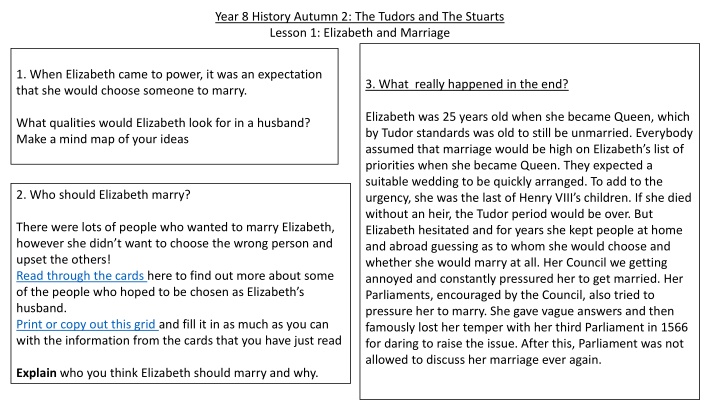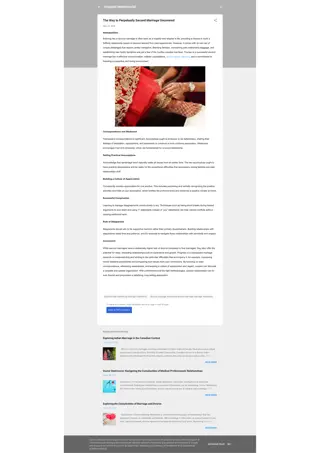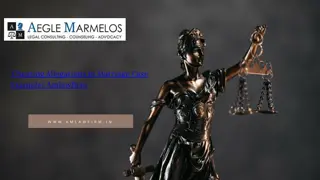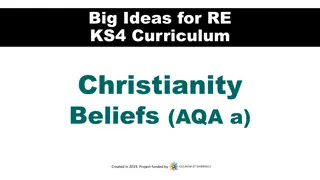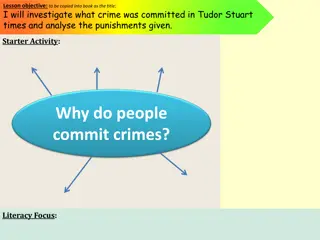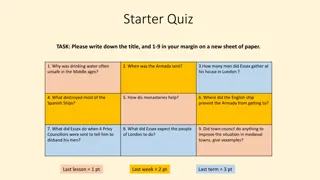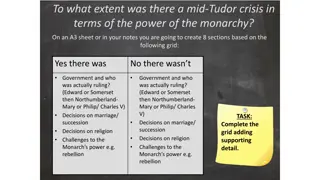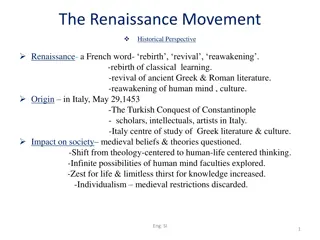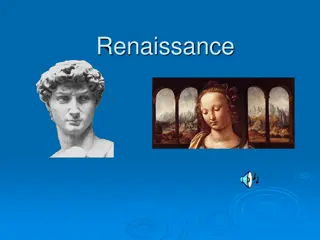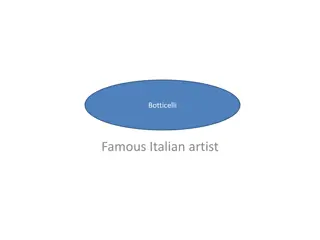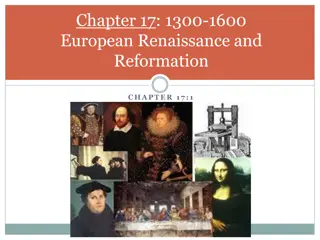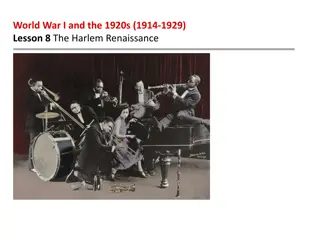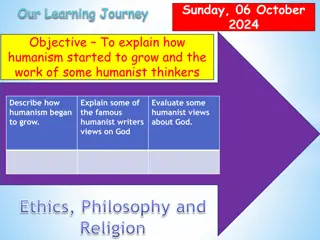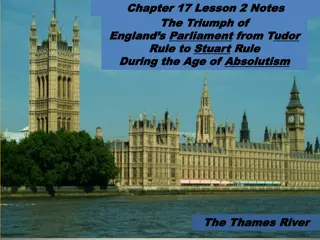Insights into Tudor and Renaissance Periods: Marriage, Medicine, and Beliefs
During this history lesson, students explore Queen Elizabeth I's reluctance to marry, potential suitors, and the development of medicine during the Renaissance period. They delve into the beliefs surrounding illness causation, treatment methods, and changes from the Middle Ages to the Renaissance.
Download Presentation

Please find below an Image/Link to download the presentation.
The content on the website is provided AS IS for your information and personal use only. It may not be sold, licensed, or shared on other websites without obtaining consent from the author.If you encounter any issues during the download, it is possible that the publisher has removed the file from their server.
You are allowed to download the files provided on this website for personal or commercial use, subject to the condition that they are used lawfully. All files are the property of their respective owners.
The content on the website is provided AS IS for your information and personal use only. It may not be sold, licensed, or shared on other websites without obtaining consent from the author.
E N D
Presentation Transcript
Year 8 History Autumn 2: The Tudors and The Stuarts Lesson 1: Elizabeth and Marriage 1. When Elizabeth came to power, it was an expectation that she would choose someone to marry. 3. What really happened in the end? Elizabeth was 25 years old when she became Queen, which by Tudor standards was old to still be unmarried. Everybody assumed that marriage would be high on Elizabeth s list of priorities when she became Queen. They expected a suitable wedding to be quickly arranged. To add to the urgency, she was the last of Henry VIII s children. If she died without an heir, the Tudor period would be over. But Elizabeth hesitated and for years she kept people at home and abroad guessing as to whom she would choose and whether she would marry at all. Her Council we getting annoyed and constantly pressured her to get married. Her Parliaments, encouraged by the Council, also tried to pressure her to marry. She gave vague answers and then famously lost her temper with her third Parliament in 1566 for daring to raise the issue. After this, Parliament was not allowed to discuss her marriage ever again. What qualities would Elizabeth look for in a husband? Make a mind map of your ideas 2. Who should Elizabeth marry? There were lots of people who wanted to marry Elizabeth, however she didn t want to choose the wrong person and upset the others! Read through the cards here to find out more about some of the people who hoped to be chosen as Elizabeth s husband. Print or copy out this grid and fill it in as much as you can with the information from the cards that you have just read Explain who you think Elizabeth should marry and why.
Lesson 2: Renaissance Medicine Task 2: Watch this video. One of our key themes this year is to think about how medicine has changed and developed throughout time. Whilst you do, try to write down 5 facts about medicine in the Renaissance period. Task 1: Retrieval What can you remember from last year about medicine in the Middle Ages? Challenge: In what ways does this seem to be similar or different to the Medieval period? If you cannot remember lots of information, read through page 2 here to help you to recap. 3. The history department have travelled back in time for you and conducted interviews with people from the Renaissance period to find out what it was like. 4. The Great Plague Read through the information here (7 pages to click through). Answer the following: How did people try to cure and prevent the plague? Were their ideas similar or different to those during the Black Death? Read the interview responses on the next 3 slides. Save a copy of the worksheet here to your own area and then use the interview responses to fill out the Renaissance column on your worksheet. Overall, how much do you think medicine changed from the Middle Ages to the Renaissance Period?
We asked: What do you believe causes illness? Hello! I live in a time when old ideas are being re-born. We have been thinking about what people in the Middle Ages thought, and we have gone back to the old texts of Galen. We don t trust the translations that were done in the Middle Ages, so we are working on translating Galen s texts again to make sure they are right! However, Galen didn t know everything and we are starting to realise he made some mistakes!! Some people living in our time still believe in Hippocrates Theory of the Four Humours, but others are starting to question it. For example, one guy called Girolamo Fracastoro has said that human disease is actually caused by pathogens and can be passed between people!! People have big arguments about this as some people think that you should not question what Galen said.
We asked: Who treats the sick and what treatments do they use? When people get poorly, they are treated by university-trained physicians (doctors) if they can afford to pay for them. Women are not allowed to go to university to train, but they play a big role in everyday medicine. They work as midwives, too. Many home remedies are handed down through generations from mother to daughter. Girls learn to mix up remedies using ingredients like honey to treat the sick. As people have started to explore more, new ingredients for medicines are arriving, such as Rhubarb. Physicians help their clients to stay healthy, advising them to have a good diet and do exercise!
We asked: If people are poorly where do they go? And what are the conditions like where you live? If people are poorly, they can sometimes go to hospitals. They are places that try to treat the sick, whereas in the Middle Ages they were mainly places of rest. Monasteries have been abolishedso new voluntary hospitals have been built. Many people are still treated at home if they are poorly. Where I live it is quite dirty. There are lots of rats, lice and fleas. We throw our waste into the street and do not have any sewers or pipes.
Lesson 3: Enter King James, the Stuart Task 1: Background information In 1603, Elizabeth died. As she had not married and had not had any children, James VI of Scotland was named her successor. This marked the end of the Tudor reign and the beginning of the Stuart period. Tasks: 1. Read through the information here about James. 2. Summarise what you feel are the most important points in no more than 5 bullet points. The Gunpowder Plot Tasks: 1. What do you already know about the Gunpowder Plot? Make a mind map showing what you know, including who it involved, what happened, when it happened and why. 2. Watch this video and then this video, and add to your mind map anything that you did not already know about the Gunpowder Plot. Task 2: Retrieval Think back to your learning on the Tudors. What had religion been like under each of the monarchs that we studied? We have looked at: Henry VIII Edward VI Mary Elizabeth Task: Complete the Google Quiz here to see what you can remember about their religious ideas. 3. Continue to add to your mind map, using the information from BBC Bitesize here. 4. From what you have learnt so far, how did life under James reign differ to what life was like in Elizabethan England?
Lesson 4: Causes of the English Civil War Some additional information: The Gunpowder Plotters were not successful in killing James Stuart. However, he was eventually succeeded by his son, Charles I, who started a civil war in England and became the only king in British history to be beheaded!!! So how did we get there? There were 2 teams , the Roundheads led by Oliver Cromwell and the Cavaliers on the side of Charles 1. Task 1: Starter Look at the picture on the next slide. It is a picture from the 1600s. Complete the following tasks in order: 1. Make a list of all of the odd things that you can spot in the picture 2. What title would you give the picture? 3. What message do you think the cartoonist is trying to send about England? VS. Additional information Below is the full title of the book cover from 1647 that the image that you have just looked at came from. Be aware that f s were used for s s at this time. Does seeing the title help to explain the strange cartoon? Roundheads were the Puritan (extreme) Protestants who were against Charles I. Oliver Cromwell- Leader of the Roundheads who were against Charles I Cavaliers- those men that were on the side of Charles I Charles I King of England in 1642 Tasks Watch the clip here. What causes of the civil war can you identify from the clip? Make a mind map of any causes that you identify. There was a major problem at the time, a thing most horrible . Any ideas what it was, or who it was between? Add to your mind map using the information in this lesson from Oak National Academy.
Lesson 5: The English Civil War Task 1: Quick retrieval Why were the Roundheads and Cavaliers fighting? Who was the leader of the Roundheads? Who was the leader of the Cavaliers? Task 2: The Weapons On the next slide is a grid, which looks like this: On the slide after that is information, which looks like this: Please read through the information and complete the grid. You can copy the grid onto paper or a word document, or save it to your own area to complete in the PowerPoint. You need to describe each weapon and explain its advantages and disadvantages on the battlefield. Challenge: Can you think of any weapons that could have the same feature as both an advantage and a disadvantage? Explain which weapon you think would have bene most effective on the battlefield and why
NAME OF WEAPON DESCRIPTION OF WEAPON WEAPON ADVANTAGE WEAPON DISADVANTAGE The Mortar The Pike Cannon Musket
The Mortar This device is easy to manoeuvre and can be used by one man alone. An explosive shell is fired high into the air and explodes on impact. Although it was difficult to aim, this weapon was the most destructive of those used in the Civil War. The Cannon The cannons used in the Civil War were very heavy and difficult to move. The largest needed a team of 16 horses to move them. The missiles fired from the cannon were usually balls of iron, but sometimes stones were used. After the cannon had been fired the soldiers operating it had to go through a strict procedure of cleaning, loading the weapon and loading the gunpowder before it could be fired again. Aiming was difficult and the cannon were more effective as a means of instilling fear into the enemy than actually causing damage. The Musket There were two types of musket; the matchlock and the flintlock, which could be as long as five feet and had a firing range of up to 300 yards. They were both loaded in the same way; gunpowder was poured into the barrel and packed in hard with a stick. Then the lead ball would be put in followed by wadding to hold the ball in place. Both weapons were dangerous and clumsy to use. Some of the longer muskets needed a rest to balance the barrel on because they were too heavy to hold. They were impossible to reload quickly and were most effective when a group of musketeers fired a volley of shots at the enemy. The Pike The Pike was one of the most commonly used weapons on the Civil War battlefield. The pike was a long wooden shaft with a steel point on the end. They were cheap to make, soldiers required very little training to use them and they could be very effective especially when used in a group. Pikes were supposed to be sixteen feet in length but often soldiers sawed a few feet off the ends to make them less difficult to carry.
Lesson 7: Charles Is Execution Lesson 6: Who won the war and why? Lesson 6 Task 1 Lesson 7 Task 1 Complete the Seneca learning here section 5.2.2 Outcome of the Civil war. Click start learning and complete the learning tasks. Watch the video lesson from Oak National Academy here and complete the tasks as instructed. Lesson 6 Task 2: The Battle of Naseby Lesson 7 Task 2 Imagine you had a seat watching Charles trial. Write a letter about the events from day 1 to day 7. At the end of the letter include your opinion and feelings on the verdict- was it the right outcome? Remember your thoughts on this will depend on whether you were a supporter of Charles or Parliament. Read through the information sheet here and complete all of the tasks in full sentences. You could also complete further research using the websites suggested. Lesson 6 Task 3 Answer the question: Who won the English Civil War and why do you think they won? You should do this in full sentences.
Lesson 8: Oliver Cromwell Lesson 9: Charles II: The King who brought back Partying? Task 1 Please watch the lesson considering different views on Cromwell and complete the tasks as you go. You will need to pause the video to give you time to complete the tasks throughout. You will need a piece of paper, or this worksheet printed or saved into your own area, and 2 different coloured pens. Click here for the video lesson. Please watch the video lesson, which is about Charles II. You will need a piece of paper and 2 different coloured pens to complete and mark the tasks, or a word document (or equivalent) open and ready to type in. Please click here for the video lesson. If you have issues accessing any of the links throughout the pack, or would like help or feedback on your tasks, please email Miss Colmer on colmer- rachael@Mayfield.Portsmouth.sch.uk , or your history teacher.
